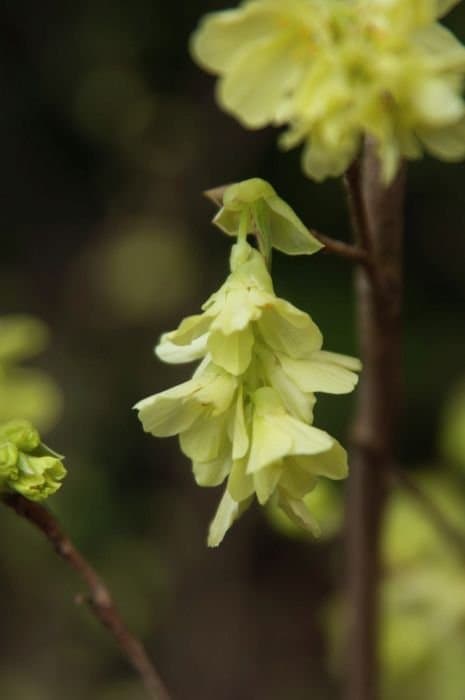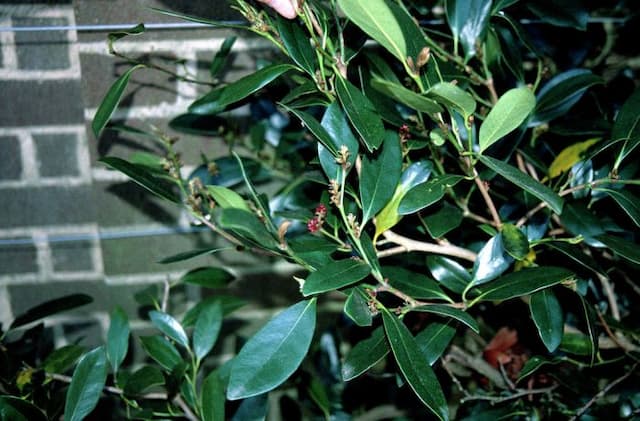Winter Hazel Corylopsis spicata

ABOUT
Corylopsis spicata, commonly known as spike winter hazel, is a deciduous shrub known for its attractive clusters of yellow flowers that bloom in early spring. Before the leaves unfurl, the plant displays pendant, chain-like flower clusters that infuse a soft yet striking visual appeal. The flowers have a delicate, sweet fragrance that adds to their charm. Following the floral display, the spike winter hazel bears ovate to rounded leaves that are light green in color, featuring a softly serrated edge. The leaves tend to hang gracefully from the branches, giving the plant a light, airy texture. In autumn, the foliage transitions to a vibrant display of yellows and golds before dropping, signifying the end of the growing season. The branches of this shrub are slender and spread outwards, often giving it a rounded and gently arching shape. The bark is smooth with a grayish-brown tone that provides a subtle backdrop to the more pronounced colors of the foliage and flowers. Overall, the appearance of spike winter hazel is characterized by its gentle and calming presence in the garden, making it a favorite among plant enthusiasts for its ornamental value.
About this plant
 Names
NamesFamily
Hamamelidaceae
Synonyms
Spike Winterhazel, Winter Hazel, Buttercup Winter Hazel
Common names
Corylopsis spicata.
 Toxicity
ToxicityTo humans
Corylopsis spicata, commonly known as the winter hazel, does not have a well-established record of toxicity to humans. No significant toxic effects have been widely reported from ingesting or coming into contact with parts of this plant. However, individual sensitivities can vary, and it's always good practice to avoid ingesting parts of ornamental plants due to potential unknown toxicities.
To pets
The winter hazel (Corylopsis spicata) is not commonly listed as toxic to pets such as dogs and cats. There is a lack of substantial evidence to suggest that animals ingesting parts of this plant will experience poisoning. Nevertheless, it is generally advisable to prevent pets from consuming plants as they could potentially cause gastrointestinal upset or allergic reactions in sensitive individuals.
 Characteristics
CharacteristicsLife cycle
Perennials
Foliage type
Deciduous
Color of leaves
Green
Flower color
Yellow
Height
5 feet [1.52 meters]
Spread
6 feet [1.83 meters]
Plant type
Shrub
Hardiness zones
5
Native area
Japan
Benefits
 General Benefits
General Benefits- Ornamental Value: Corylopsis spicata, commonly known as Winter Hazel, adds aesthetic appeal to gardens with its cascading yellow flowers in early spring.
- Wildlife Attraction: The plant's flowers provide nectar for early-season pollinators such as bees.
- Seasonal Interest: Winter Hazel's early bloom time brings welcome color to gardens after the winter season.
- Fragrance: The flowers emit a pleasant scent that can add a layer of sensory enjoyment to a garden space.
- Shade Tolerance: As an understory shrub, Winter Hazel can thrive in partial shade, making it versatile for various garden designs.
- Fall Foliage: In autumn, the leaves of Corylopsis spicata turn to attractive shades of yellow and gold, adding seasonal interest.
 Medical Properties
Medical PropertiesThis plant is not used for medical purposes.
 Air-purifying Qualities
Air-purifying QualitiesThis plant is not specifically known for air purifying qualities.
 Other Uses
Other Uses- Corylopsis spicata, commonly known as spike winter hazel, can be used in woodworking and carpentry for its decorative wood with a fine grain that may be suitable for inlays and fine furniture.
- The flexible branches of spike winter hazel can be utilized in basket weaving, offering a natural and unique appearance to handmade baskets.
- The fragrant flowers of spike winter hazel can be used in the crafting of natural perfumes, providing a subtle, spring-like scent profile to fragrance blends.
- As a natural dye, the leaves and bark of spike winter hazel may be employed to create soft yellow or light brown dyes for fabrics and yarns.
- In landscape gardening, spike winter hazel is utilized for bonsai, appreciated for its attractive form, delicate flowers, and ease of training.
- The plant can serve as a teaching tool in botany education, illustrating plant life cycles, pollination processes, and the variety of temperate flora.
- Spike winter hazel's vibrant yellow flowers can be used in flower arrangements, adding a pop of color and a touch of spring to indoor settings.
- The dense growth habit of spike winter hazel makes it suitable for creating privacy screens or hedges in residential and park landscapes.
- For wildlife gardens, planting spike winter hazel provides an early source of nectar for pollinators such as bees and butterflies emerging in the spring.
- The fallen leaves of spike winter hazel, rich in organic matter, can be composted to improve soil quality in gardens and landscaping.
Interesting Facts
 Feng Shui
Feng ShuiThe Winter Hazel is not used in Feng Shui practice.
 Zodiac Sign Compitability
Zodiac Sign CompitabilityThe Winter Hazel is not used in astrology practice.
 Plant Symbolism
Plant Symbolism- Elegance: With its delicate hanging clusters of yellow flowers, Corylopsis spicata, commonly known as Spike Witch Hazel, symbolizes elegance and a refined beauty.
- Early Spring: As one of the early bloomers, Spike Witch Hazel represents the anticipation of spring and new beginnings.
- Hope: The bright flowers emerging often while the last grips of winter remain can signify hope and the promise of warmer days.
- Sensitivity: The plant's subtle appearance and fragrance suggest a sense of sensitivity and delicate emotions.
 Water
WaterWinter Hazel should be watered deeply once a week, allowing the soil to dry out slightly between waterings. In hot, dry weather, increase watering to twice a week, providing about 1 to 1.5 gallons of water each time for a medium-sized shrub. During the winter, reduce watering to every other week or less, depending on the soil moisture level. Be careful not to overwater, as Winter Hazel does not like soggy soil. Use a soaker hose or drip irrigation system for the most efficient watering, directing the water to the root zone.
 Light
LightWinter Hazel prefers to grow in partial shade to full sun. The ideal spot for this plant is one where it can receive filtered sunlight or morning sun and afternoon shade. Avoid placing it in locations where it will be exposed to harsh midday sun, which can scorch the leaves. A location with dappled light beneath the canopy of taller trees would be ideal for maintaining the vibrant foliage of the Winter Hazel.
 Temperature
TemperatureWinter Hazel thrives best in a temperature range of 60°F to 75°F but can tolerate temperatures as low as 0°F once established. Avoid exposure to extreme heat above 85°F for prolonged periods, as this can stress the plant. Winter Hazel is reasonably cold hardy but should be protected from frost and freezing temperatures when young or when the plant is in bloom.
 Pruning
PruningWinter Hazel should be pruned to remove any dead, damaged, or diseased branches and to maintain its shape. The best time for pruning is immediately after flowering in the spring, as the plant blooms on old wood. Pruning yearly or every other year is usually sufficient. Light pruning can be done to encourage a bushier growth habit and to enhance the shrub's natural form.
 Cleaning
CleaningAs needed
 Soil
SoilWinter Hazel thrives in well-draining, humus-rich soil with a pH between 5.0 and 6.5. A mix of two parts garden soil, one part peat moss, and one part perlite or coarse sand is ideal.
 Repotting
RepottingWinter Hazel should be repotted every 2 to 3 years to refresh the soil and accommodate root growth.
 Humidity & Misting
Humidity & MistingWinter Hazel prefers moderate to high humidity levels but is generally adaptable to average household humidity.
 Suitable locations
Suitable locationsIndoor
Place Winter Hazel in bright, indirect light with high humidity.
Outdoor
Grow Winter Hazel in partial shade, sheltered from strong winds.
Hardiness zone
5-8 USDA
 Life cycle
Life cycleCorylopsis spicata, commonly known as spike winter hazel, begins its life cycle as a seed that germinates in the late spring after a period of stratification, where it requires cold temperatures to break dormancy. Upon germination, the seedling develops a root system and a shoot that emerges above the soil, growing into a small shrub. As the plant matures, it develops a multi-stemmed habit with deciduous leaves that emerge after the plant has produced clusters of fragrant, yellow flowers in early spring before the leaves unfold. During the growing season, the plant undergoes photosynthesis and nutrient accumulation, preparing for the dormant period in winter. In autumn, the leaves of the spike winter hazel turn a notable yellow color before they fall, signaling the plant's entry into dormancy. This annual cycle of growth, reproduction, and dormancy repeats throughout the plant's life, which can span several decades under favorable conditions.
 Propogation
PropogationPropogation time
Spring-Early Summer
Corylopsis spicata, commonly known as spike winter hazel, is often propagated by taking softwood cuttings in late spring or early summer. The process involves choosing a healthy, non-flowering branch and making a cut to obtain a piece of stem about 4 to 6 inches (10 to 15 cm) long. This cutting is then stripped of its lower leaves, and the cut end is dipped in a rooting hormone to stimulate root development. The prepared cutting is placed in a well-draining potting mix, ensuring the soil is kept moist but not waterlogged. A transparent plastic bag or dome can be placed over the cutting to maintain high humidity and reduce water loss, though care must be taken to avoid overheating in direct sunlight. Roots typically develop within a few weeks, after which the new plant can be gradually acclimatized to less humid conditions before being planted out.









